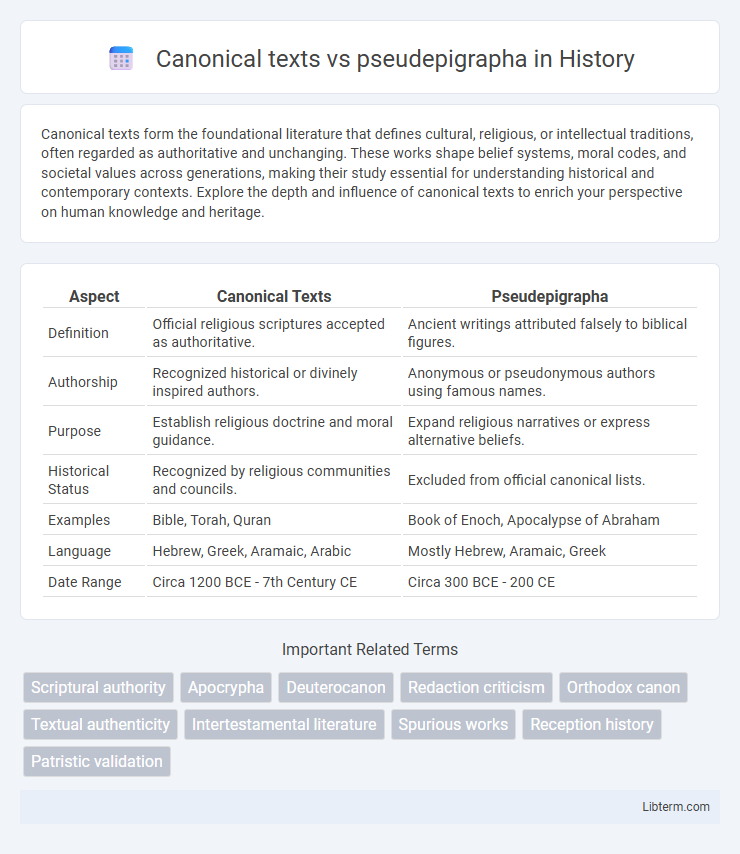Canonical texts form the foundational literature that defines cultural, religious, or intellectual traditions, often regarded as authoritative and unchanging. These works shape belief systems, moral codes, and societal values across generations, making their study essential for understanding historical and contemporary contexts. Explore the depth and influence of canonical texts to enrich your perspective on human knowledge and heritage.
Table of Comparison
| Aspect | Canonical Texts | Pseudepigrapha |
|---|---|---|
| Definition | Official religious scriptures accepted as authoritative. | Ancient writings attributed falsely to biblical figures. |
| Authorship | Recognized historical or divinely inspired authors. | Anonymous or pseudonymous authors using famous names. |
| Purpose | Establish religious doctrine and moral guidance. | Expand religious narratives or express alternative beliefs. |
| Historical Status | Recognized by religious communities and councils. | Excluded from official canonical lists. |
| Examples | Bible, Torah, Quran | Book of Enoch, Apocalypse of Abraham |
| Language | Hebrew, Greek, Aramaic, Arabic | Mostly Hebrew, Aramaic, Greek |
| Date Range | Circa 1200 BCE - 7th Century CE | Circa 300 BCE - 200 CE |
Introduction to Canonical Texts and Pseudepigrapha
Canonical texts are authoritative scriptures recognized within religious traditions, forming the foundational doctrines and practices, such as the Bible in Christianity or the Torah in Judaism. Pseudepigrapha consist of ancient writings falsely attributed to notable figures and are not included in the official canon, often offering insights into historical beliefs and cultural contexts. Understanding the distinction highlights the criteria of authenticity, theological significance, and cultural impact that define canonical acceptance versus the exploratory value of pseudepigraphal literature.
Defining Canonical Texts
Canonical texts are authoritative scriptures recognized by religious communities for their theological consistency, historical authenticity, and widespread acceptance, often forming the foundation of doctrinal teachings. These texts are distinguished from pseudepigrapha, which are writings falsely attributed to notable figures and excluded from the official canon due to questions about authorship and doctrinal reliability. The defining features of canonical texts include their validation through tradition, doctrinal coherence, and their role in shaping the beliefs and practices of faith communities.
Understanding Pseudepigrapha
Pseudepigrapha are ancient writings falsely attributed to biblical figures, differing significantly from canonical texts which are officially recognized scripture. These texts offer valuable insights into religious thought and cultural contexts of various historical periods despite lacking canonical authority. Scholars analyze pseudepigrapha to understand the development of religious ideas and the diversity of early Jewish and Christian beliefs.
Historical Development of the Biblical Canon
The Historical Development of the Biblical Canon involved the gradual recognition and collection of canonical texts, which were formally accepted as inspired Scripture by religious communities, distinguishing them from pseudepigrapha--writings falsely attributed to biblical figures and excluded from official canon lists. Canonical texts underwent rigorous theological scrutiny and historical validation to establish their authenticity, while pseudepigrapha often reflected diverse theological agendas or legendary traditions without authoritative status. Key councils, such as the Council of Jamnia and the Church councils in the 4th century, played pivotal roles in affirming the canon, solidifying the distinction between canonical texts and pseudepigraphal literature.
Criteria for Canonical Inclusion
Criteria for canonical inclusion emphasize authoritative authorship, doctrinal consistency, and widespread liturgical use, distinguishing canonical texts from pseudepigrapha. Canonical texts are often attributed to recognized prophets or apostles with verifiable historical connections, while pseudepigrapha lack such credible authorship claims. Textual reliability and alignment with established theological frameworks further influence the acceptance of texts into the canon.
Examples of Canonical Texts
Canonical texts in religious traditions include the Bible's Old and New Testaments, the Quran in Islam, and the Vedas in Hinduism, recognized for their authoritative theological teachings. Examples of canonical scriptures are the Torah, Psalms, and Proverbs in Judaism, the Gospels of Matthew, Mark, Luke, and John in Christianity, and the Bhagavad Gita within Hindu literature. These texts establish foundational doctrines and are distinguished from pseudepigrapha, which are writings falsely attributed to biblical figures and considered non-canonical.
Notable Pseudepigraphal Works
Notable pseudepigraphal works include the Book of Enoch, the Testament of Solomon, and the Apocalypse of Abraham, which are significant for their influence on early Jewish and Christian thought despite their exclusion from canonical scriptures. These texts often explore angelology, eschatology, and divine judgment, offering rich theological and mythological insights absent from canonical writings. Their pseudonymous authorship serves to attribute authority while reflecting diverse religious traditions outside the established canon.
Theological Implications of Authorship
Theological implications of authorship in canonical texts shape doctrinal authority, as these texts are traditionally attributed to divinely inspired figures, establishing their sacred legitimacy. Pseudepigrapha, often falsely ascribed to revered authors, challenge canonical boundaries and raise questions about authenticity, interpretive authority, and the transmission of theological traditions. This distinction influences the reception, doctrinal formulation, and canonical acceptance within religious communities.
Impact on Religious Traditions and Beliefs
Canonical texts serve as authoritative foundations shaping religious doctrines, rituals, and ethical norms, establishing a cohesive framework for faith communities. Pseudepigrapha, though excluded from official canons, influence religious thought by offering alternative narratives and interpretations that challenge or enrich mainstream beliefs. The dynamic interaction between canonical texts and pseudepigrapha drives theological development, doctrinal debates, and diverse expressions of spirituality within religious traditions.
Contemporary Relevance and Scholarly Debates
Canonical texts hold enduring authority in religious traditions, shaping contemporary theological discourse and ethical frameworks, while pseudepigrapha provoke critical examination of textual authenticity and historical context. Scholarly debates focus on the criteria for canonicity, historical authorship, and the influence of these writings on cultural identity and religious practices. Contemporary relevance emerges from ongoing analysis of their distinct roles in shaping faith, tradition, and academic study within religious communities.
Canonical texts Infographic

 libterm.com
libterm.com